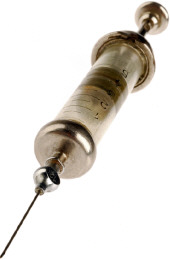



Research Focuses on Proper Vaccine Administration Techniques
By Mississippi State University, published in MSU Poultry Dept. Newsletter Vol. 1 Issue 3. Numerous methods are currently utilized throughout the poultry industry for the administration of vaccines. Vaccine delivery to birds in commercial poultry houses occurs via three predominant methods: drinking water, eye drop or spray. Spray administration often results in non-uniform application and inconsistent response by the birds’ immune sys-tems, however, it is desirable for both ease and cost of application. Spray vaccination is the preferred method for inoculating the respiratory system of poultry, but non-uniform and inconsistent vaccine administration can result in a “rolling reaction” within a flock which in turn can result in longer recovery with the overall impact of decreased flock performance. Within the commercial table egg sector of the poultry industry, spray application is considered to be the most effective delivery system for the administration of most Mycoplasma gallisepticum (MG) vaccines, and has become increasingly popular for the administration of Newcastle disease virus and infectious bronchitis virus vaccines.
Vaccine delivery systems significantly influence the outcome of vaccination. While improper vaccine ad-ministration is the most common reason for vaccine and vaccination program failure, procedures for the reconstitution/dilution of vaccines for dispersal can also be an important factor in vaccine effectiveness. Essentially, all poultry vaccines, whether administered via drinking water, eye drop or spray, utilize water as both the means of vaccine reconstitution and as the delivery medium. Water characteristics such as pH, tonicity/osmolarity (mineral content), temperature and source (well, municipal or distilled) may impact vaccine effectiveness. Other important factors to consider are spray nozzles, nozzle spray pattern, delivery pressure, the possibility of vaccine suspension/stratification in the vaccinator reservoir and the time from vaccine reconstitution/dilution to final vaccine dispersal to the chicken.

Several recent research projects at the USDA-ARS Poultry Research Unit at Mississippi State have been conducted to study many of these factors affecting vaccine administration in commercial poultry operations. One such experiment focused on the relationship between live MG vaccine viability and the factors of water temperature and time. Experiments were conducted with 3 commercially available MG vaccines: F strain, 6/85 strain and ts-11 strain. All 3 vaccines were reconstituted in distilled water at 3 temperatures (39°, 72° and 90°F). Survival of the live MG vaccines was assessed after initial reconstitution (0 minutes) and at 15, 30 and 60 minutes post reconstitution. Results indicated that the 6/85 strain MG vaccine remained consis-tently viable over all time period periods at all 3 temperatures tested. The F strain vaccine viability was most quickly reduced with 90°F water compared to 39 and 72°F water, with significantly reduced viability im-mediately after initial reconstitution. A similar trend was observed with the ts-11 stain vaccine at 90°F, but not until 15 minutes after mixing. Viability of the ts-11 stain continued to be significantly reduced at 30 and 60 minutes after mixing at 90°F. Overall, the data from this study suggests that distilled water used to reconsti-tute and dilute live MG vaccines should be relatively cool to maintain and prolong the viability of the organisms.
Researchers have also evaluated additives that can be used to adjust the pH and tonicity/osmolarity of water used to reconstitute vaccines. One such product tested was a reformulation – based on USDA-ARS Poultry Research Unit studies - of Spray-Vacâ, a vaccine additive, manufactured by Animal Science Products, Inc., Nacogdoches, TX. This product was found to be effective for not only MG vaccines, but also viral vaccines such as Newcastle and infectious bronchitis. Spray-Vacâ can be used with distilled, municipal or well water. This product prevents the decline of vaccine titers often seen when vaccines are diluted in chlorinated or distilled water because it helps adjust the pH and counteracts the chlorine in the water that may kill the vaccine organisms. It also colors the water so the user knows for sure the water has been treated.
Additional work has studied the factor of vaccinator delivery pressure and its relationship to nozzle size, which affects both delivery rate and droplet size. Three types of nozzles (coarse, medium and fine) were tested at 40 and 60 psi to determine the droplet sizes generated as well as “as applied” coverage and deposition. The median droplet size ranged from 154 to 192 mm for all combinations of nozzles and pressure, with little corre-lation to the nozzle classification by the nozzle manufacturer. Very few respirable droplets (<10 mm ) were observed for any treatment. Coverage and deposition were greatest for the “coarse” nozzle, followed by the “medium” and “fine” nozzles. Vaccine viability appeared unaffected by any of the treatments tested. The relative similarity of droplet sizes coupled with the dis-parity of coverage and deposition between nozzle types indicated that delivery rate is of greater concern than droplet size, especially given the negligible amount of respirable droplets observed.











